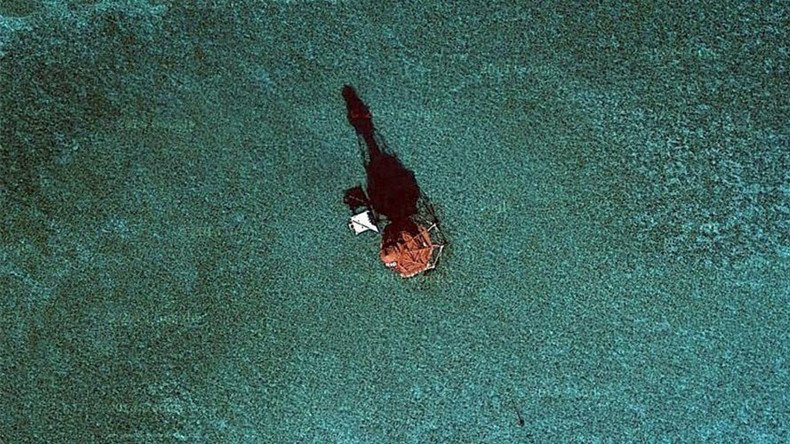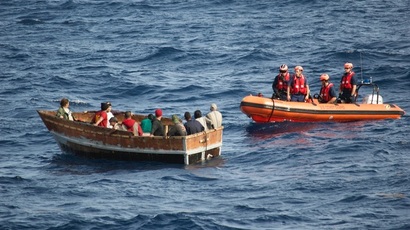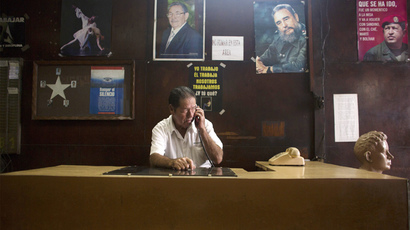Cuban migrants found clinging to offshore lighthouse to be sent home

Cuban migrants who reached a historic lighthouse in the Florida Keys must return to their home country after a federal judge ruled it is not considered US soil. Their capture was preceded by an hours-long standoff with the Coast Guard.
On May 20, the US Coast Guard spotted an unregistered boat south of Cudjoe Key, which it pursued until it experienced engine trouble. While two of the boat’s occupants complied with Coast Guard orders and were taken into custody, the remaining occupants “armed themselves with metal pipes, jumped into the ocean, and swam” to the nearby American Shoal Lighthouse.
20 Cuban migrants have climbed the American Shoal lighthouse 7 miles south of Florida Keys. @SkyforceHD 1st on scene pic.twitter.com/TTY0EbLUdN
— Frank Guzman (@fguzmanon7) May 20, 2016
After a nearly eight-hour standoff between government agents and the migrants, the 19 Cubans in the lighthouse agreed to come down and were taken into custody. The next day, two more people were spotted on the lighthouse, while a third was discovered an hour and a half later, “clinging to a wooden board.” In total, the Coast Guard took 24 Cuban migrants into custody.
The migrants have been aboard a Coast Guard cutter while their fates were decided by a federal court. At issue in the case is whether the 136-year-old American Shoal Lighthouse, which stands in shallow waters about 7 miles (11km) off the Florida Keys, is considered to be dry land, thus invoking the so-called “Wet-Foot/Dry-Foot Policy.”
The policy states: “Cuban migrants intercepted at sea by the United States and attempting to enter the United States will be taken to Cuba,” while those who reach US soil are able to remain in the country. “Wet-Foot/Dry-Foot” is the result of a 1994 agreement between the two countries regarding their “common interest in preventing unsafe departures from Cuba which risk loss of human life.” However, the policy remains a point of contention between the US and its neighbor ‒ even as they seek to normalize relations after more than five decades ‒ with Cuban President Raul Castro slamming the practice of granting automatic residence to migrants who reach dry land in a speech in December.
The structure of the 109-foot (33m) lighthouse is more akin to an offshore oil rig than a typical lighthouse. It sits 4 ft (1.3m) above a coral reef that has proven dangerous to passing ships, and contains a two-story, octagonally shaped keeper’s dwelling 40 ft (12m) above the water. The lighthouse, automated since 1963, remained operational until 2015.
“The closest dry land is seven miles away. The US Coast Guard reviewed the situation and determined the light tower was in the water, was not on dry land,” Assistant US Attorney Dexter Lee argued at a hearing earlier this month.
Plaintiff witness Jose Abreu, an engineer, testified about the lighthouse’s structure and history, defining it as a permanent structure within US territory, WFOR reported.
"This is a federal building, on federal land, in federal territory," said Kendall Coffey, a former US attorney who is among the migrants' lawyers, according to WTVJ. "We believe they are entitled to not being repatriated" to Cuba.
Cubans rescued at sea after being shot by 'criminals who wanted to steal their raft' https://t.co/LsSNLjlcfBpic.twitter.com/YLCBYQYfKb
— RT America (@RT_America) March 28, 2016
Lawyers for the migrants also argued that a previous case presented a precedent to allow the group to be considered “feet dry.” In 2006, Democracy Movement successfully argued that 15 Cuban migrants who were found on a piling of the abandoned Seven Mile Bridge in the Florida Keys qualified as “feet dry” because the structure was part of US territory. The US Department of Homeland Security had determined that the old span, located next to a newer version of the bridge, was no longer connected to dry land because it had sections missing. A federal judge sided with the Cubans.
On Tuesday, Judge Darrin Gayles sided with the Coast Guard, ruling that the structure does not count as American territory, and thus the Cubans are considered “feet wet.” The judge noted that he was “mindful of the proper role of federal courts in such matters,” citing the Elian Gonzalez case in 2000.
"The Court neither approves nor disapproves the Executive Branch's decision that the Cuban migrants in this case do not qualify for refugee processing as dry foot arrivals to the United States," Gayles wrote. "Developments and revisions of immigration and foreign policy are left to the political branches of the government."
Because Congress has not specifically defined the parameters of the Wet-Foot/Dry-Foot Policy, the Coast Guard, under the umbrella of the Executive Branch, was tasked with making that determination, the judge noted. In this case, the government’s decision that the structure is not part of US territory falls “within the range of reasonable choices,” he wrote.
“No one has resided in the Lighthouse since at least 1963. As an abandoned —and dangerous—structure over seven miles from the closest dry land, no one today would live on the Lighthouse,” Gayles wrote. “It has never been connected to dry land,” and because the migrants “would necessarily require transportation from the Lighthouse to the mainland in order to survive, landing on the Lighthouse is essentially no different than having been interdicted at sea.”
Representatives for the migrants expressed disappointment in Gayles’ ruling.
"This is a very sad moment for all of us," Cuban immigration advocate Ramon Saul Sanchez, who leads the Democracy Movement, told reporters outside the courthouse. "We have had our day in court but we had hopes that freedom would also be enjoyed by these people after they invested so much of their lives."
William Calderon, one of the lawyers representing the migrants pro bono for the Democracy Movement, told the Miami Herald he is unsure whether the group will appeal the decision.
"We are disappointed with the ruling… but that is just one part of the case," Sanchez said. "We still have legal avenues at our disposal."
Following the ruling, the Coast Guard announced that the 24 migrants would be repatriated according to US immigration policy.














